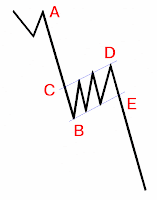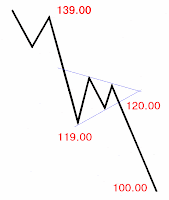Price gaps, as plotted on bar charts, are very common in the currency futures market. Although currency futures may be traded around the clock, their markets are open for only about a third of the trading day. For instance, the largest currency futures market in the world, the Chicago IMM, is open for business 7:20 am to 2:00 pm CDT. Since the cash market continues to trade around the clock, price gaps may occur between two days' price ranges in the futures market.
There are four types of gaps: common, breakaway, runaway, and exhaustion.
Common Gaps
Common gaps have the least technical significance of all the types of gaps. They do not indicate a trend start, continuation, reversal, or even a general direction of the currency other than in the very short term. Common gaps tend to occur in relatively quiet periods or in illiquid markets. When price gaps occur in illiquid markets, such as distant currency futures expirationdates, they must be completely ignored. The entries for distant expiration dates in currency futures are made only on a closing basis, and they do not reflect any trading activity. Never trade in an illiquid market because getting out of it is very difficult and expensive. When gaps occur within regular trading ranges, the word on the street has been that, "Gaps must be filled.". Common gaps are short term. When currency futures open higher than yesterday's high, they are quickly sold, targeting the level of the previous day's high.
Breakaway Gaps
Breakaway gaps occur at the beginning of a new trend, usually at the end of long consolidation periods. They may also appear after the completion of some chart formations that tend to act as short-term consolidations.Breakaway gaps signify a brisk change in trading sentiment, and they occuron increasingly heavy trading. Traders are understandably frustrated by consolidations, which are rarely profitable. Therefore, a breakout from the slow lane is embraced with optimism by the profit-hungry traders. The price takes a secondary place to participation. As always, naysayers follow the initial breakout. Sooner rather than later, the pessimists have no choice but to join the new move, thus creating more volume.
Breakaway gaps are not likely to be filled during the breakout and for the duration of the subsequent move. In time, they may be filled during a new move on the opposite side.
 |
| Figure 5.34. A typical breakaway gap. |
1. A breakaway gap provides the price direction.
2. There is no price objective.
3. Increasing demand for a currency ensures a solid move on good volume in the foreseeable future.
From a technical point of view, runaway, or measurement, gaps are special gaps that occur within solid trends. They are known as measurement gaps because they tend to occur about midway through the life of a trend. Thus, if you measure the total range of the previous trend and extrapolate it from the measurement gap, you can identify the end of the trend and yourprice objective. Since the velocity of the move should be similar on both sides of the gap, you also have a time frame for the duration of the trend.
Trading Signals for Runaway Gaps
1. The runaway, or measurement, gap provides the direction of the market. As a continuation pattern, this type of gap confirms the health and the velocity of the trend.
2. Volume is good because traders like trends, and confirmed trends attract more optimism and capital.
3. This is the only type of gap that also provides a price objective and a time frame. These characteristics are also useful for developing hedging
Exhaustion gaps may occur at the top or bottom of a formation when trends change direction in an atypically quick manner. There is no consolidation next to the broken trend line: The trend reversal is very sharp through a bullish move, looks a lot like a measurement gap. So traders buy the currency and stay long overnight on that assumption. The following day the market opens below the previous low, generating a second gap. If the second gap is filled or does not even occur, the trading signal remains the same. Traders do not have to get caught badly in this exhaustion gap. A sudden trend reversal is unlikely to occur in an information void. Some sort of identifiable event triggers the move—maybe a government fall or a massive and well-timed central bank intervention. Therefore, traders should at least be warned.































